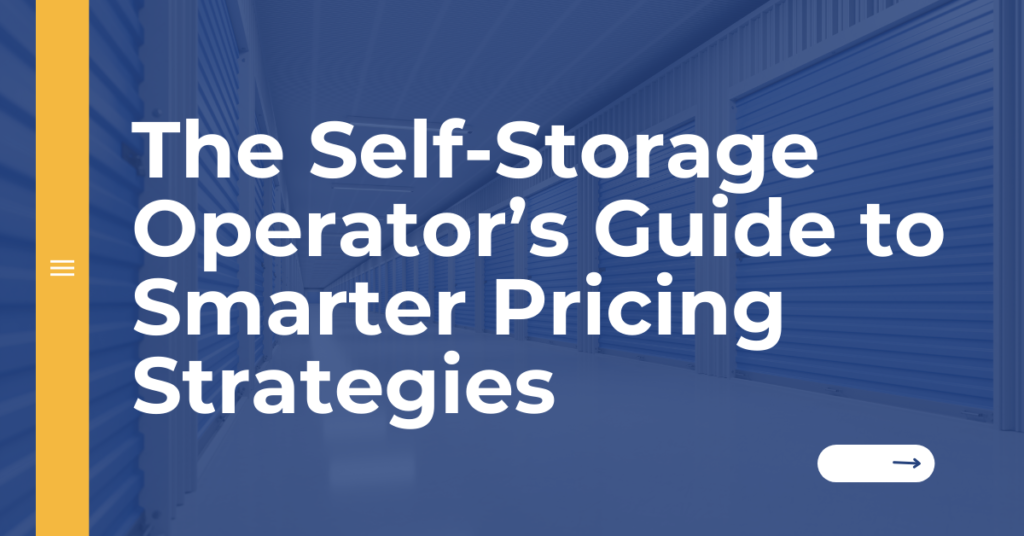Are Your Self-Storage Pricing Strategies Ready for Today’s Challenges?
Navigating the self-storage industry’s pricing landscape can feel like solving a complex puzzle. With the post-pandemic boom leveling off, small operators face increased competition, fluctuating occupancy rates, and the pressing need to maintain profitability. Large REITs have adapted by employing sophisticated, data-driven pricing models. But what about independent operators managing self-storage facilities? How can you implement smart pricing strategies to not only stay afloat but thrive in this evolving market? Let’s explore actionable insights and proven tactics to help you optimize your pricing for success.
1. Why Pricing Strategy is the Key to Profitability
Pricing isn’t just about filling up units—it’s about maximizing revenue without compromising occupancy. A strong pricing strategy ensures that your facility remains competitive while maintaining profitability.
Key pricing mistakes operators make:
- Flat-rate pricing: Charging the same price for all units regardless of features (e.g., ground-level vs. upper-floor, drive-up vs. interior).
- Cutting prices too aggressively: Entering a price war with competitors can lead to long-term losses.
- Overlooking consumer psychology: Customers respond to pricing strategies like anchoring, tiered pricing, and charm pricing.
- Ignoring market trends: Not adapting to changing demand can leave units sitting vacant while competitors adjust.
The following pricing strategies will help you increase occupancy and revenue without racing to the bottom.
2. Tiered Pricing: Why One-Size-Fits-All Pricing Doesn’t Work
Tiered pricing allows you to offer different pricing levels for units based on features such as:
- Climate control vs. non-climate control
- Ground-floor vs. upper-floor
- Drive-up access vs. interior units
- Proximity to entrances or elevators
For example, instead of charging a flat rate for all 10×10 units, you could price a drive-up 10×10 unit at a premium while offering a discounted rate for upper-floor units. This approach increases revenue while providing options for budget-conscious customers.
3. Dynamic Pricing: Adjusting Rates in Real Time
Dynamic pricing is the practice of adjusting rental rates based on demand, occupancy, and competitor pricing. Large REITs have successfully used this approach to maximize revenue, and independent operators can implement a similar strategy by:
- Increasing prices for high-demand units and decreasing rates for slower-moving inventory.
- Monitoring local competitor pricing to ensure your rates remain attractive.
- Adjusting pricing seasonally based on peak storage demand times.
This strategy ensures that you maximize rental income while keeping occupancy high.
4. Consumer Psychology and Pricing
Understanding how customers perceive pricing can help you implement effective pricing tactics. Here are three key psychological pricing strategies:
A. Charm Pricing
- Prices ending in “.99” or “.95” create a perception of a better deal (e.g., $99 vs. $100).
- Studies show that consumers are more likely to choose a product priced at $99.99 rather than $100, even though the difference is negligible.
B. Price Anchoring
- Show a higher-priced unit first so that lower-priced options appear more attractive.
- If a ground-floor unit is priced at $180, displaying a drive-up unit at $210 makes the $180 unit feel like a bargain.
C. Limited-Time Discounts
- Create a sense of urgency by offering temporary discounts (e.g., “First month free if you book today”).
- Customers are more likely to commit if they believe they are getting an exclusive deal.
5. Walk-In vs. Online Pricing: How to Maximize Each
REITs have leveraged walk-in vs. online pricing to increase revenue. Many large operators charge higher rates for in-store customers while offering lower rates for online bookings. Why? Because customers who visit in person are already committed and less likely to shop around.
How to implement this strategy:
- Offer a slightly lower rate for online reservations to encourage digital bookings.
- Maintain higher in-store pricing to maximize revenue from walk-ins.
- Ensure your staff is trained to sell the value of premium-priced units.
6. Strategic Discounts That Drive Profits
Discounts are a double-edged sword. If used correctly, they can attract new customers without hurting revenue. If misused, they can lead to lower profitability.
Best practices for offering discounts:
- Tie discounts to the length of stay. Instead of offering one-month free promotions, offer “25% off for the first 4 months” to lock in longer commitments.
- Incentivize long-term contracts. A small discount for a 6- or 12-month lease can improve retention.
- Avoid blanket discounts across all unit types. Instead, discount only units that are harder to fill.
7. Expanding Pricing Strategies with Advanced Theories
Value-Based Pricing: Charge for Perceived Value, Not Just Features
Most storage facilities price units based on size and location, but what if you priced based on perceived value to the customer? Value-based pricing shifts the focus from cost or competition to what your customer is willing to pay.
Price Elasticity: How Sensitive Are Your Customers to Price Changes?
Understanding how price changes impact rental volume helps determine whether to raise rates or adjust for customer retention.
Penetration Pricing vs. Skimming Pricing: Two Discounting Strategies
- Penetration Pricing: Lower prices initially, then gradually increase as demand builds.
- Skimming Pricing: Start high, gradually lowering for more price-sensitive customers.
Bundling & Upselling: Increase Revenue Without Cutting Rates
Instead of discounting, bundle services or upsell premium features to boost revenue.
8. Case Study: How These Strategies Led to Higher Revenue in 2024
At Cubix Asset Management, we implemented dynamic pricing, tiered pricing, and walk-in vs. online pricing models to great success. Here are some key takeaways:
- Occupancy remained strong at 92.29% even as market rates fluctuated.
- Average rent per square foot increased by 3.5%, outperforming major REITs.
- Walk-in pricing resulted in a 7.09% increase in revenue per square foot.
- 12,848 rate increases were implemented, leading to a 4.82% revenue increase.
- 9-month rate lock guarantee improved customer retention and lifetime value.
Want to see exactly how we achieved these results? Learn more about our in-depth case study on implementing pricing strategies, optimizing facility operations, and boosting overall revenue. Get real insights and strategies that you can apply to your facility today.
9. Final Takeaways: Implementing Your Own Profitable Pricing Strategy
By adopting these proven pricing strategies, independent self-storage operators can increase revenue, improve occupancy, and compete effectively without resorting to price wars.
Let’s take the guesswork out of pricing for your self-storage facility. Schedule a free facility operation and revenue analysis with our experts at Cubix Asset Management. We’ll provide a comprehensive evaluation tailored to your facility’s unique challenges and opportunities. Contact us today and discover how data-driven pricing can unlock new growth for your business.
FAQ: Common Pricing Concerns
Q: How do I know if my pricing strategy is working?
A: Track key metrics like occupancy rate, revenue per square foot, and customer retention. If your occupancy stays stable while revenue grows, your strategy is effective. Use A/B testing to compare different pricing models and adjust based on performance.
Q: How do I increase rates without losing customers?
A: Use a gradual rate adjustment rather than sudden spikes. Offer value-based justifications (e.g., improved security, facility upgrades) and provide rate lock guarantees to ease concerns. Prioritize existing customers with loyalty incentives while adjusting new tenant rates dynamically.
Q: What’s the best way to price units in a competitive market?
A: Implement tiered and dynamic pricing—adjust rates based on demand, unit features, and competitor pricing. Offer walk-in vs. online pricing strategies to maximize revenue and create incentives for digital bookings. Stay competitive by monitoring local market trends and adjusting accordingly.




